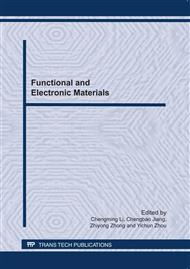p.106
p.112
p.117
p.122
p.129
p.133
p.138
p.144
p.151
Magnetic Properties of Highly Permeable MnZn Ferrites with Addition of Phosphorous Pentoxide
Abstract:
The effects of phosphorous pentoxide on the properties of highly permeable MnZn ferrites have been investigated in this study. It was found that P2O5 addition had a pronounced effect on promoting crystalline grain growth. At the same time, porosity had an initial decrease followed by a subsequent increase with the increase of P2O5 content. Consequently, the initial permeability first increased, and then gradually decreased. Magnetic loss of the samples was also influenced by both grain size and porosity. With 0.06wt% P2O5 addition, the initial permeability reached to the maximum and the magnetic loss declined to the least. Porosity was the dominating factor to determine the ηB (hysteresis material constant) property of the ferrites. With 0.04wt% P2O5 addition, porosity decreased to its bottom, accordingly, the ηB value decreased to the least. Synthetically considering high initial permeability, low ηB value and good permeability frequency characteristic, the content of P2O5 addition had better be kept at 0.04wt%.
Info:
Periodical:
Pages:
129-132
Citation:
Online since:
June 2011
Authors:
Keywords:
Price:
Сopyright:
© 2011 Trans Tech Publications Ltd. All Rights Reserved
Share:
Citation:


